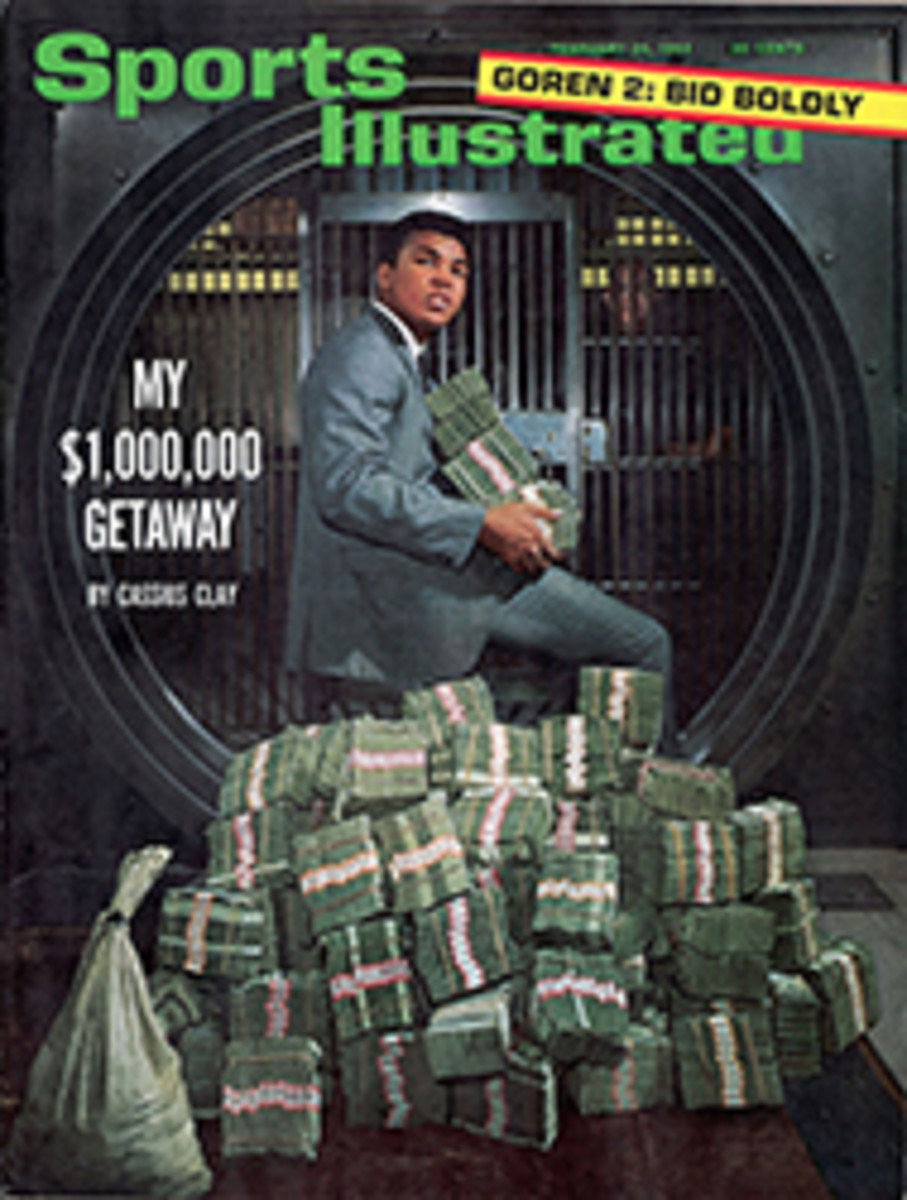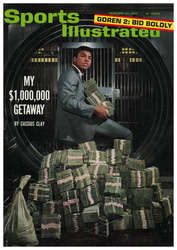
From humdrum to well-done in one easy mile
Tom O'Hara took five seconds less than a minute last week to turn what had been a rather humdrum indoor track and field season into one of roaring excitement. The pale, skinny, slump-shouldered kid from Chicago—standing around in a hotel lobby before a meet, he looks more like a bellhop than an athlete—sprinted through the last quarter of the Baxter Mile at the New York Athletic Club indoor games in Madison Square Garden in 55 seconds flat to set a new indoor world record of 3:56.6.
O'Hara had been sweeping mile races all winter long, but his previous victories seemed, in retrospect, to have been little more than training exercises in preparation for the big one. At the Millrose Games in New York in January, for instance, he followed John Camien closely through a 3:05.6 three-quarters before running a 55-second final quarter to win easily in 4:00.6. A week later, at the Los Angeles Times games, he toyed with Jim Grelle, a sub-four-minute miler himself, dawdling past three quarters in an amusingly slow 3:12 before opening that same old 55-second last-quarter sprint to beat Grelle by a dozen yards.
But in New York last week the pace was sharper and quicker. It was perfectly suited to O'Hara. Tom lagged in last place for a while, running in his usual monkey-on-a-tightrope manner, his hands held rather high and away from his body, as though for balance. He moved up to second place after the first quarter and really began to pay attention to things when he heard that the half-mile time was 2:01.3. Ideas of a record began to form in his head. John Camien was setting the pace at this point and driving hard, but O'Hara was in complete control.
About 500 yards from home he hitched up his pants, a characteristic gesture he makes several times a race, to the delight of the fans, and went to work. He flipped past Camien. opened up a six-yard lead and, with slightly less than 300 yards to go, turned his sprint on full throttle. He ran away from Camien and the field (in two laps his lead lengthened from 10 to 65 yards) and all by himself raced toward the record, looking immensely strong and sure of himself. He never labored and when he crossed the finish line, running faster than he had at any point earlier in the race, he showed almost no sign of strain or exhaustion. He had run the last half mile in 1:55.3.
It was the first sub-four-minute mile of the indoor season, and by two full seconds the fastest indoor mile ever run. It was also an awesome demonstration of running power and notice to the world that the man to beat in the Olympic 1,500 meters next fall in Tokyo may be little Tom O'Hara instead of big Peter Snell, the New Zealander who holds the world outdoor mile record at 3:54.4. Snell has been beaten this summer season in New Zealand, and no other world times, indoors or out, have come close to O'Hara's.
Indeed, O'Hara's New York mile seemed to shake the indoor season out of its lethargy, and everything took on a heightened interest. For instance, two nights after O'Hara's record mile, Australian Ron Clarke met 17-year-old Gerry Lindgren of Spokane in a two-mile race in San Francisco. It developed into one of the finest performances of the year and whetted everyone's appetite for the distance events still to come before the indoor season ends next month. Clarke, who had broken world records for six miles and 10,000 meters outdoors in Australia this past December, boasted times that were more than half a minute faster for each race than anyone else in the world ran them last year. When he and his fellow Australian, High Jumper Tony Sneazwell, arrived in America two weeks ago, they were expected to have an immediate and salubrious impact on the indoor season, not only because of their own impressive credentials but because two other track men from Australia and New Zealand, Albie Thomas and Bill Baillie, had been tremendously impressive in brief, earlier visits. Thomas tied the indoor world record for three miles in Toronto, and Baillie just missed the indoor two-mile record in Portland, Ore. Thomas and Baillie had had to return home almost immediately after their fine races, but Clarke and Sneazwell were to be here for almost a month, during which they would compete in at least five and possibly six indoor meets.
Unfortunately for promoters, their debuts were vaguely disappointing. While Sneazwell did jump 7 feet in his first indoor competition (last autumn he cleared 7 feet 2‚Öù inches), he lost to John Thomas in his first meet. He then suffered a muscle pull high in his thigh and cleared only 6 feet 11 and 6 feet 10 in third-and first-place finishes.
Clarke, in his first race ever indoors, ran two miles in 8:42.6, which is good, but he looked tired and weak and finished a rather flat second to America's Bob Schul in a curiously dull race. Next time out, in New York, Clarke seemed much stronger than before but appeared to be confused by the strategy and tactics of running on the tight little 160-yard wooden oval. Bruce Kidd of Canada won this race in 8:42.6 by a yard over Schul, with Clarke only one second behind.
Then came the San Francisco meet, in which Clarke went against the youthful Lindgren. Neither Schul nor Kidd was entered, and Clarke was faced with a direct challenge. Losing to internationalists like Schul and Kidd was one thing: losing to a 117-pound high school boy would be quite another. Lindgren made a spirited bid (and lowered his amazing record for two miles for a high school runner to 8 minutes and 40 seconds), but Clarke's strength and experience prevailed. After a back-and-forth duel, he pulled away from Lindgren in the last lap to win by 20 yards in 8:36.9.
"It's a very different feeling, running on these small tracks," Clarke said. "Before I came over I read that Gaston Roelants of Belgium did 8:41.4 in Los Angeles in his first go at the boards, and I thought that was rather weak. I talked about doing 8:35 or better. Now I feel different. And I've learned that you should expect to do your best, but you shouldn't predict."
Clarke is an exceptionally good-looking man, dark-haired, dark-eyed, with a flashing smile and a warm friendly manner. He is sure of himself, as all Australians seem to be, but in a matter-of-fact, almost impersonal way. His career has been an odd one. Back in 1956, before anyone had ever heard of Herb Elliott, Clarke was Australia's most promising young runner (an Aussie Gerry Lindgren, so to speak). At 18 he held a myriad of junior records at distances from 880 yards on up ("Herb Elliott broke them all later on," Clarke says, grinning), and at the Melbourne Olympics in 1956 he was given the honor of running the Olympic torch into the stadium on the very last leg of its long journey from Greece. He received an extraordinary amount of publicity at the time, not to mention scores of burns, and even today he is better known to many people as the bearer of the Olympic torch than he is as the breaker of world records.
But he began to study accountancy. In the interests of furthering his business career, he gave up training. He continued to run competitively in local meets, but that was just about the only running he did and his times became ordinary. Then about three years ago (and, coincidentally, after Herb Elliott had retired), Clarke decided that serious training would no longer interfere with his work. He built up his stamina by running great distances in practice. In competition his times improved remarkably, year by year, until suddenly, at 26, married and with two small children, he was back to where he was at 18, on top of the heap.
His 1963 record behind him, he now must be made the strong favorite to win the Olympic 10,000-meter run, and he should be a factor, too, in the 5,000 and the marathon, in both of which he expects to compete. And this Saturday, in New York at the AAU indoor national championships, it might be a good idea to keep your eye on Clarke in the three-mile run. Two miles is a bit short for his neat, rhythmic, beautifully balanced style of running, but it is hard to imagine anyone beating him at three miles. What O'Hara revived so dramatically—the excitement of a runaway world record—Ron Clarke of Australia may well continue.
PHOTO
A RELAXED O'HARA SPEEDS PAST FINISH

